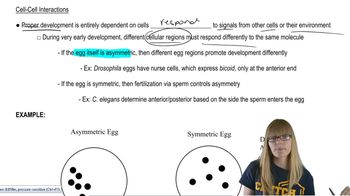A pure-breeding tall plant producing oval fruit as described in Problem 2 is crossed to a pure-breeding short plant producing round fruit.
If the F₁ identified in part (a) are crossed to one another, what proportion of the F₂ are expected to be short and produce round fruit? What proportion are expected to be tall and produce round fruit?
Two parents plan to have three children. What is the probability that the children will be two girls and one boy?
 Verified step by step guidance
Verified step by step guidance
Verified Solution
Key Concepts
Probability Basics

Binomial Distribution

Combinatorial Analysis

In mice, black coat color is dominant to white coat color. In the pedigree shown here, mice with a black coat are represented by darkened symbols, and those with white coats are shown as open symbols. Using allele symbols B and b, determine the genotypes for each mouse.
A man, J.B., has a sister with autosomal recessive galactosemia (OMIM 230400), and his partner, S.B., has a brother with galactosemia. Galactosemia is a serious condition caused by an enzyme deficiency that prevents the metabolism of the sugar galactose. Neither J.B. nor S.B. has galactosemia, but they are concerned about the risk that a future child of theirs will have the condition. What is the probability their first child will have galactosemia?
A woman, S.R., had a maternal grandfather with hemophilia A (OMIM 306700), an X-linked recessive condition that reduces blood clotting. S.R.'s maternal grandmother and paternal grandparents are free of the condition, as are her partner, his parents, and his grandparents. S.R. has no siblings. She wants to know the chance that a son of hers will have the condition. What is that probability?
